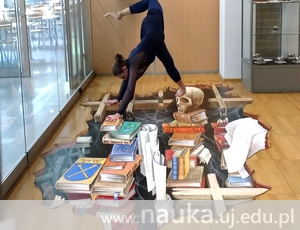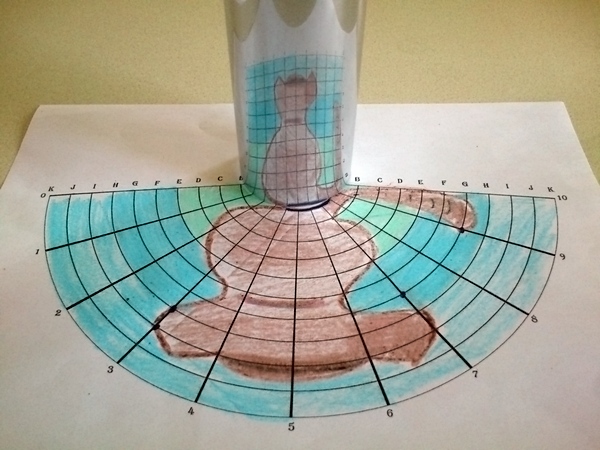
Ada Pałka’s research projects is a fusion of art and science. Her main interest is anamorphic projection.
Ada Pałka is a PhD student at the Chair in Geometry of the JU Institute of Mathematics. Under the supervision of Dr hab. Robert Wolak, she investigates optical illusions and anamorphosis. She concentrates mostly on catoptric anamorphosis, especially cases involving conical mirrors. She focuses chiefly on the works by Jan Ziarnko from the turn of the 16th and 17th century, particularly his graphic art entitled Para kochanków [A couple of lovers]. In it, the artist employed a technique based on distortion grids. He first described this method in his 1619 book Perspectiva stereo graphicae pars specialis, which was an inspiration for Ada Pałka.When mathematics meets art
Anamorphosis is a distorted projection or perspective requiring the viewer to use special devices or occupy a specific vantage point (or both) to reconstitute the image. ‘So we may ask: what geometrical rules describe these reconstitutions? How should we classify them? Do these tricks have any applications in the modern world? These are the questions that we try to answer with mathematics. They point to a close relationship between art and mathematics’, said Ada Pałka.

Every work of art draws from mathematics in some way. ‘From perspective and orthographic projection through music and dancing to theatre and architecture, everything is at some point connected to mathematics. When artists create their work, they are following the elementary rules of geometry. I decided to focus on anamorphosis. Knowledge of mathematics really helps me understand the nuances of anamorphosis creation’, explained the researcher.
Anamorphosis is usually perceived as an interesting optical illusion, and sometimes used as a non-standard way of advertising. Its purpose is to surprise the viewers and attract their attention. Lately, there have been some ideas about using it in public spaces, e.g. creating 3D zebra crossings with increased visibility.
One thing that helps Ada Pałka in documenting the cases of anamorphosis is her fascination with photography. As she puts it, she’s interested in ‘weird photography’, and she’s trying to recreate the old photography techniques.
Anamorphosis in a library
In an effort to share her research with the public, she initiated a project entitled Weird perspective in Poland. An exhibition of old documents, manuscripts and anamorphic works. The exhibition was held at the Jagiellonian Library and comprised over 40 anamorphic images and paintings. The idea was first conceived during numerous conversations with staff members of libraries across Poland. The exhibition met with great interest from the general public. Although anamorphosis has been described in centuries-old books, it's still very much relevant.
Photograph below the title: Anamorphosis by Ryszard Paprocki and Marcin Czaja. Photograph by Ada Pałka. Model: Sara Damm.
Original text: www.nauka.uj.edu.pl





